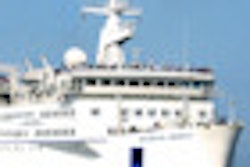
The world and its people have been struck by a number of natural disasters in the last few years, most notably the tsunami that hit Indonesia at the end of 2004 to Hurricanes Katrina and Rita that demolished the U.S. Gulf Coast in 2005. In the aftermath of these kinds of disasters -- as well as in the daily, ongoing work of providing basic healthcare to poor or developing nations -- medical workers on hospital vessels, including radiologists and radiological technologists, have offered crucial care.
The global charity organization Mercy Ships, based in Garden Valley, TX, has operated a hospital ship with an all-volunteer staff around the world since 1978. The organization's current focus is sub-Saharan Africa. Radiology is used for orthopedic and general x-ray applications, and medical staff work with patients who present with conditions such as cleft lips or palates, cataracts, old trauma and orthopedic injuries, head and neck tumors, incontinence, and vesicovaginal fistulas (VVF).
 |
| The Caribbean Mercy Ship. © Mercy Ships International. |
Mercy Ships is a Christian organization, and although volunteers need not be Christian to serve, they should be comfortable with a faith-based work environment, according to Dr. Glenn Strauss, ophthalmologist and senior vice president of Mercy Ships' International Healthcare Services and Programs. Although Mercy Ships staff does serve in emergencies, its main mission is to provide ongoing, specialized medical services to underserved populations.
Mercy Ships' main vessel is the Anastasis, a 522-ft ship that has three operating rooms, a dental clinic, a laboratory, an x-ray unit, and 1,500-ton cargo capacity. Another ship, the Africa Mercy, will be launched in 2007. Mercy Ships also operates two land-based clinics in Sierra Leone.
The Anastasis doesn't have a full-time radiologist on board, but instead its clinicians consult via the Internet with radiologists at academic centers around the world. The ship does have two full-time radiology technologists on board, however, to operate the vessel's CT scanner -- usually five to six exams per day, according to Strauss -- and its analog x-ray unit for standard radiological chest or neck exams.
 |
| An orthopedic surgical suite on board a Mercy Ship. © Mercy Ships International. |
Interested certified radiological technologists can apply for a volunteer stint on the Mercy Ships Web site; a typical term of service is three to six months, Strauss said, although some volunteers have stayed for as long as a year. Another way to volunteer with Mercy Ships is to contribute radiology consulting services. Volunteers aboard the ship can expect to see rare or advanced conditions, like untreated head or neck tumors that deform the patient's face and become life-threatening because of the danger of suffocation rather than the malignancy of the tumor itself, according to Strauss.
Mercy Ships provides an on-board, one-week orientation for short-term volunteers; volunteers serving for one or more years participate in an in-depth, three-month training before beginning their term.
"Although our ships have equipment and stability that one wouldn't necessarily find in an African hospital, there are still language barriers and cultural differences that make the work challenging," Strauss said.
U.S. Navy
The U.S. Navy runs two hospital ships under the auspices of its Military Sealift Command (MSC): the USNS Comfort, based in Baltimore, MD, and the USNS Mercy, based in San Diego, CA. Both ships' primary mission is to provide quick and mobile medical/surgical services to U.S. armed forces, but they also provide disaster relief.
 |
| Kupang, Indonesia (August 22, 2006) -- Navy Hospital Corpsman 2nd Class Ronald Bayaca of San Diego performs a CT scan on a patient aboard the USNS Mercy (T-AH 19) during the ship's visit to Kupang. U.S. Navy photo by Mass Communication Specialist Seaman Joseph Caballero. |
The USNS Mercy has a total patient capacity of 1,000 and 12 operating rooms. The U.S. Navy uses civilian volunteers via its partnership with Project Hope, an international organization based in Millwood, VA, that was founded in 1958 to establish relationships between medical professionals in the U.S. and in developing countries, as well as to provide medicines and supplies.
 |
| Dili, East Timor (August 27, 2006) -- Navy Capt. Arden Chan, attached to the Military Sealift Command hospital ship USNS Mercy (T-AH 19), looks at the x-rays of a local resident with the director of the Bairo Pite Clinic, Dr. Dan Murphy. U.S. Navy photo by Chief Mass Communication Specialist Don Bray. |
 |
| Dili, East Timor (August 29, 2006) - Military Sealift Command hospital ship USNS Mercy (T-AH 19). U.S. Navy photo by Chief Mass Communications Specialist Edward G. Martens. |
Project Hope began with a donated Navy hospital ship, the USS Consolation, which was renamed the SS Hope and made 11 humanitarian voyages before being retired in 1974. Project Hope offers its services to the U.S. government during times of disaster, and its volunteers worked with Navy staff on the USNS Mercy to care for Southeast Asian tsunami and Hurricane Katrina survivors.
In addition to shipboard medical care, many other organizations give radiologists or radiological technologists opportunities to help around the world. These include the American Red Cross, Doctors of the World, Doctors Without Borders, InterAction: American Council for Voluntary International Action, and International Medical Corps.
By Kate Madden Yee
AuntMinnie.com contributing writer
November 21, 2006
Related Reading
Siemens makes multimillion-dollar donation to Clinton initiative, September 21, 2206
Radiology rises to the occasion for Katrina survivors and victims, December 27, 2005
Ocean Springs hospital thanks RT volunteers, September 12, 2005
Zimbabwe hospital installs WHIS-RAD unit, June 16, 2003
Copyright © 2006 AuntMinnie.com


















